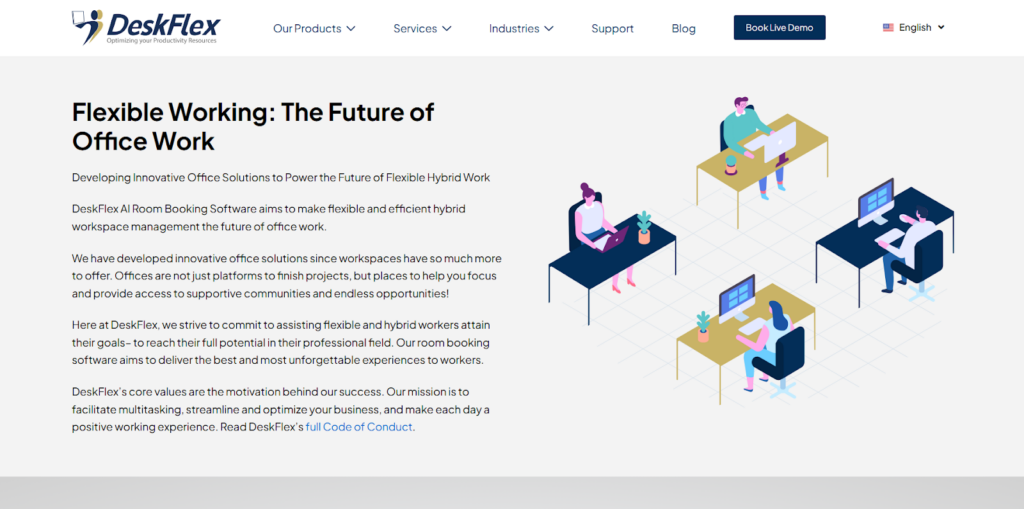Managing office spaces has become more challenging. It comes with the increasing popularity of hybrid work models and flexible schedules. Hot desk solutions offer a practical way for businesses to adjust by turning static office setups into flexible environments that meet different needs.
These systems allow employees to access workspaces when needed. At the same time, it helps organizations maximize space usage and minimize waste.
In this article, we will talk about what hot desk solutions are, their benefits, and how they operate. We will also discuss some of the leading software available and how you can choose the right one for your business.
What Are Hot Desk Solutions?
Hot desk solutions are workplace systems that allow employees to use desks or workspaces on a first-come, first-served basis or through a reservation system.
Unlike assigned desks, these setups offer more flexibility and accommodate hybrid and mobile workers while reducing unused space.
Technology plays a major role in hot desk systems. Desk and room booking software solutions allow employees to:
- Reserve desks
- Locate available spaces
- Manage bookings in real-time
These tools also provide insights into desk usage patterns. It also helps companies plan their office layouts more efficiently.
How Does Hot Desking Work?
Hot desking operates through a combination of structured systems and processes. These methods allow businesses to efficiently manage desks, meeting rooms, and shared spaces. It prioritizes flexibility, real-time adjustments, and optimal use of office resources.
Desk Booking with Reservation Systems
Reservation systems allow employees to book desks before arriving at the office. These systems display the current availability of desks. It gives employees the ability to select workspaces based on their preferences or tasks.
Booking systems often operate through desktop software or mobile apps to make them accessible from anywhere. This eliminates confusion over desk usage and promotes an organized approach to workspace allocation.
Interactive Maps for Desk Selection
Interactive maps show the layout of the office and highlights available:
- Office desks
- Meeting rooms
- Collaborative areas
Maps simplify the process of locating and selecting a workspace. It reduces the time spent searching for a desk.
Employees can use these maps to find private offices that meet their needs. For instance, someone looking to work closely with a team can choose a desk near a collaborative zone.
Real-Time Updates on Availability
Hot desking systems provide real-time updates on the availability of desks and meeting rooms. These updates allow employees to make quick decisions about where to work.
Changes, such as a canceled reservation or a newly available desk, appear instantly in the system. Real-time updates reduce delays and improve the overall flow of workspace use.
Check-In Systems for Desk Confirmation
Check-in systems confirm desk use by requiring employees to log their arrival. Employees complete this step through:
- Mobile apps
- Physical desk devices
- Web platforms
If someone does not check in within a set period, the desk becomes available for others to use. This prevents reserved desks from remaining empty due to unclaimed bookings.
First-Come, First-Served Desk Allocation
In offices without reservation systems, hot desking operates on a first-come, first-served basis. Employees arriving at the office choose from the desks that are open.
This offers flexibility without the need for prior booking. However, it requires compliance with clear policies to avoid conflicts over desk selection.
Space Usage Monitoring Through Analytics
Hot desking systems track how desks and shared spaces are used. Analytics tools collect data on:
- Occupancy patterns
- Popular areas
- Underused desks
This helps businesses adjust their office layouts and resource allocation. For example, analytics might reveal that certain desks remain unused. It prompts changes to seating arrangements or repurposing of the space.
Integration with Workplace Tools
Many hot desking systems connect with workplace tools like Google Workspace or Microsoft Teams. These integrations allow employees to coordinate desk bookings with their schedules, meetings, or team activities.
For instance, an employee attending multiple meetings can reserve a desk near the conference rooms for easier access. Integration simplifies the planning process and reduces scheduling conflicts.
Mobile Access for Desk Management
Mobile access allows employees to manage their desk bookings from their smartphones. Employees can:
- Reserve desks before arriving at the office
- Check resource availability
- Update their reservations as needed
This supports hybrid work models. Employees gain the flexibility to plan their workday from anywhere.
Automatic Release of Unused Desks
When employees do not check-in for a reserved desk, the system releases the space after a designated time. This prevents desks from sitting idle and opens them for other employees. Automatic releases keep the office environment agile and responsive to real-time needs.
Work Zones for Varied Tasks
A hot desk booking software organizes offices into zones that suit different work styles. Employees can choose the same desk to work in. There are also quiet zones that offer spaces for focused tasks, while collaborative areas support teamwork and brainstorming.
Employees choose their desks based on the task they need to complete. This flexibility helps employees match their workspace to their daily goals to improve productivity and satisfaction.
Integration of Meeting Room Management
Hot desk booking systems often include tools for managing meeting rooms. Employees can book these rooms alongside their desk reservations. These tools track meeting room availability and space usage. It reduces conflicts and increases access to shared resources.
Resource Allocation Based on Real-Time Data
Hot desk booking software collects and analyzes real-time data to allocate resources efficiently. If the system identifies that certain desks or areas are frequently unoccupied, businesses can repurpose those spaces.
Similarly, high-demand zones can be adjusted to better meet employee needs. This data-driven approach keeps office layouts relevant and practical.
How to Choose the Right Hot Desk Solution
Selecting the right hot desk solution involves a detailed evaluation of business needs, office dynamics, and the features that each system offers. A well-chosen solution improves space management, supports employee productivity, and aligns with the unique requirements of your workplace.
1. Identify Office Needs and Goals
Understanding the specific needs of your office is the first step in choosing a hot desk solution. You have to assess information such as:
- How many employees use the office regularly
- Percentage of hybrid workers
- Type of workspaces required
Determine whether your office requires additional tools for managing meeting rooms, private offices, or shared resources. For example, a team-focused office may need a system that supports collaboration zones, while a quiet office might benefit from features that allocate private desks.
2. Look for Compatibility with Existing Tools
Hot desk systems that work with the tools your business already uses provide smoother integration. Evaluate systems that connect with platforms such as Google Workspace, Microsoft Outlook, or Slack.
These integrations simplify desk booking and help employees align their workspaces with their schedules. A system compatible with existing workflows reduces disruption and encourages employees to use the platform.
3. Review Features and System Capabilities
A strong hot desk solution should address your key requirements. Look for features like:
- Desk reservation systems
- Real-time availability updates
- Interactive office maps
- Check-in tools
Systems with analytics provide insights into desk usage to plan layouts and resource allocation. If your office has remote workers, choose a system with mobile access. It will allow employees to manage their bookings remotely.
Consider whether additional features, like meeting room management or visitor access tools, would add value to your office operations.
4. Focus on Simplicity and User Experience
Employees need to interact with the system daily, so simplicity matters. Choose a hot desk solution with an intuitive interface that is easy to work with.
Systems that allow quick reservations, clear desk visibility, and simple check-in processes work best to improve the employee experience. Complex platforms discourage usage and create unnecessary barriers.
5. Evaluate Analytics and Reporting Features
Systems that track desk usage and provide analytics offer significant advantages. These tools show patterns in how desks, meeting rooms, and shared spaces are used. Check reports on:
- Occupancy rates
- Peak usage times
- Underused spaces
These reports will guide decisions about layouts and resource planning. A system with strong reporting capabilities helps you adjust space allocation to match employee needs.
6. Consider Scalability for Future Growth
Businesses change over time, and your hot desk solution must adapt to those changes. Choose a system that can handle increasing employee numbers, new office locations, or changes in work models.
A scalable solution avoids the need for frequent upgrades or replacements. It will save time and resources in the long term.
7. Assess Customer Support and Maintenance
Reliable support and maintenance are integral for keeping the system operational. Evaluate the vendor’s track record in responding to technical issues and providing regular updates.
Poor support can disrupt office operations, especially during peak hours. Look for vendors with positive reviews and a proven history of assisting customers efficiently.
8. Compare Pricing and Value
Hot desk systems come with different pricing models based on:
- Software features
- Platform scalability
- Integration options
Compare the costs of various solutions and determine whether the features align with your budget. Factor in potential cost savings from improved space utilization, reduced real estate expenses, and increased productivity when calculating the value of the system.
9. Test with Demonstrations and Trial Periods
Requesting a demonstration or trial period allows you to test the system. During the trial, evaluate how well the system handles desk booking, resource management, and employee engagement.
Test the system from an employee’s perspective to confirm ease of use. You can gather feedback from employees and observe how it affects employee efficiency. A trial period provides a practical understanding of the system’s functionality.
What Are The Benefits of Hot Desking
Hot desking provides practical advantages for businesses looking to optimize office space usage while adapting to work patterns. This system supports flexible arrangements, reduces costs, and improves resource management.
Maximizing Space in the Office
Hot desking eliminates the inefficiency of unused desks. Traditional office setups often leave many workstations empty due to:
- Employee absences
- Vacations
- Remote work
Hot desking addresses this problem by reallocating desks based on actual attendance. This allows businesses to use the available space more productively. It avoids wasted space and increases overall workplace efficiency. Offices can operate more smoothly and avoid unnecessary clutter.
Lowering Real Estate Expenses
Implementing hot desking reduces the need for large office spaces. Companies no longer need to provide permanent desks for every employee, especially when many work remotely or part-time. With fewer fixed desks, businesses can even consider smaller offices.
It lowers expenses related to rent, utilities, and maintenance. This allows businesses to allocate resources where they matter most, while still maintaining functional workspaces. The financial savings from reduced real estate needs directly benefit company budgets.
Adapting to Hybrid Work
Hot desking provides flexibility for businesses that have hybrid work models. Employees who split their time between the office and home no longer require permanent workstations. Hot desking also matches desk availability with the daily presence of employees.
It creates a system that works with changing attendance patterns. This gives employees a workspace when they need it. Offices also become more adaptable to shifting work schedules.
Encouraging Collaboration and Communication
Hot desking creates opportunities for interaction between employees who might not normally work together. Without fixed seating arrangements, employees move through different areas of the office.
This flow across the workspace encourages teams to:
- Collaborate with each other
- Share work ideas
- Communicate more efficiently
Employees working in shared spaces gain exposure to fresh perspectives, which supports creativity and teamwork.
Providing Employees with Choice
Hot desking gives employees the freedom to choose workspaces that suit their tasks. Employees can pick the same desk they often use. Those who need to concentrate on detailed projects may select quieter areas, while those working on group activities can position themselves closer to their teams.
This ability to pick the most suitable workspace helps employees focus better on their tasks. It improves their comfort and productivity throughout the day.
Optimizing Resource Management
Hot desking systems often include tools that track space usage. These tools provide businesses with valuable data on how desks, meeting rooms, and shared areas are used. Managers use this information to reconfigure office layouts and allocate resources better.
For example, underused spaces can be converted into collaborative areas or quiet zones. High-demand areas can be expanded or reorganized to meet employee needs. This allows offices to function at their best and maximizes workspace efficiency.
Reducing Environmental Impact
Hot desking helps businesses minimize their environmental footprint. Companies consume less energy on heating, cooling, and lighting. Smaller office spaces require fewer resources, which further reduces energy consumption and operational costs.
Companies also decrease their overall carbon footprint and contribute to sustainability goals. Hot desking supports a more environmentally conscious approach to workplace management.
Optimize Your Workspace with DeskFlex Hot Desk Solutions
DeskFlex offers a practical solution for managing office spaces and supporting flexible work environments. The platform simplifies desk booking and helps businesses allocate resources efficiently and reduce unused workstations.
Employees can use DeskFlex to book desks quickly and focus on their tasks without unnecessary delays.
Features, such as interactive office maps, allow employees to locate and reserve available desks in real-time. Mobile access makes it possible to book workstations from anywhere, while integrations with tools like Outlook and Microsoft Teams align desk reservations with daily schedules.
DeskFlex will also give businesses valuable insights through analytics. Organizations use this data to identify trends, make adjustments to office layouts, and create a workspace that supports productivity. It aligns resources with employee needs and helps businesses make the most of their office spaces.
Don’t miss out on the benefits of DeskFlex and optimize your workspace management. Book a demo today!
FAQs About Hot Desk Solutions
How do hot desk solutions help businesses?
Hot desk solutions help businesses organize office spaces more efficiently. These systems reduce unused desks, lower real estate costs, and create flexible seating arrangements that adapt to different work styles. They also help businesses allocate resources based on real-time data and employee needs.
Can hot desk solutions handle hybrid work models?
Hot desk systems align well with hybrid work environments. Employees book desks based on their schedules to allow businesses to match workspace availability with actual attendance. These systems help hybrid employees coordinate their time in the office and access resources easily.
What features improve usability in hot desk solutions?
Hot desk systems often include tools such as interactive maps, mobile app access, and real-time updates on desk availability. Some platforms also include team zones, desk amenities, and automated check-ins to simplify the user experience and reduce booking conflicts.
How do hot desk solutions improve collaboration?
These systems support collaboration by grouping desks into team zones or neighborhoods. Employees book spaces near colleagues or within specific team areas. Some solutions also show where team members are seated to help employees plan their workspace choices.
What data insights do hot desk solutions provide?
Hot desk platforms track desk usage, attendance patterns, and space allocation. Analytics from these systems highlight underused areas and trends and helps businesses make informed decisions about layouts, seating arrangements, and resource allocation.




